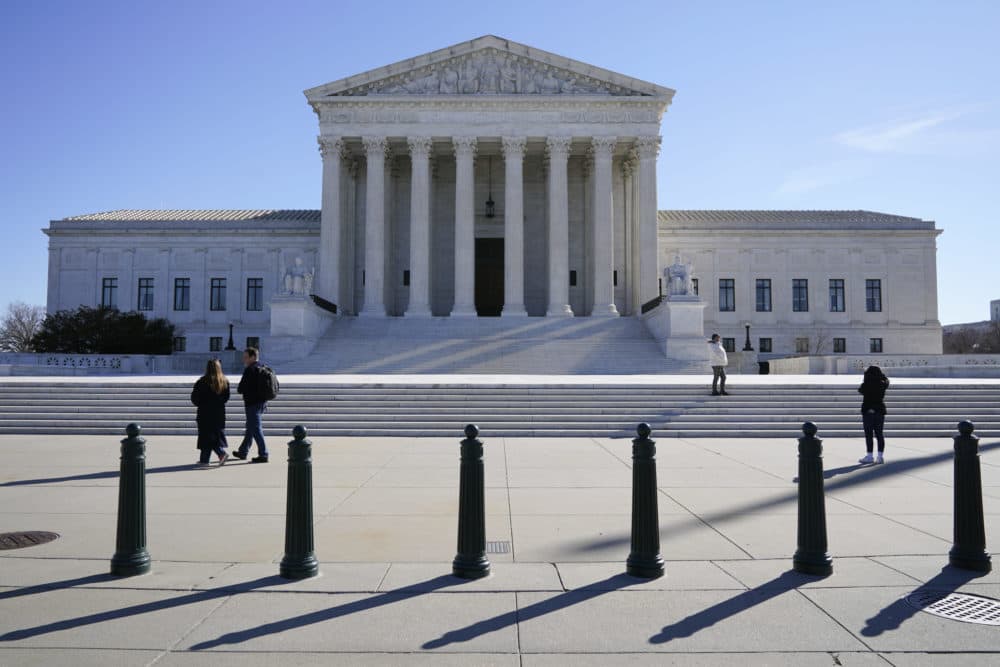Advertisement
The future of affirmative action
Resume
Sign up for the On Point newsletter here.
The Supreme Court set a precedent for affirmative action more than 40 years ago.
Now that precedent hangs in the balance as the court considers it again. What could be at risk?
At the University of Michigan, after the state banned affirmative action in its public universities in 2006:
“A 90% drop in the number of entering first year undergrads when it comes to Native Americans, and I think a 50% drop when it comes to African Americans," Michelle Adams says.
"I think what the university is saying is if you eliminate affirmative action nationwide, we’re going to see a lot of the same kinds of reaction.”
Today, On Point: The future of affirmative action.
Guests
Michelle Adams, professor at the University of Michigan Law School. Her research centers on race discrimination, school desegregation, affirmative action, and housing law.
Richard Kahlenberg, education policy researcher and writer with expertise in education, civil rights and equal opportunity.
Also Featured
Zachary Bleemer, assistant professor of economics at the Yale School of Management. Research associate of opportunity insights and the Center for Studies in Higher Education.
Transcript: Inside California's affirmative action ban
KIMBERLY ATKINS STOHR: We've discussed how affirmative action as a policy has helped improve diversity at different levels, including when it comes to higher education.
Let's turn now to California, where in 1996, Proposition 209 was approved to prohibit state governmental institutions from considering race, sex or ethnicity in public employment, public contracting and public education.
ZACHARY BLEEMER: So we have this great visualization of how UC Berkeley conducted admissions in 1995. Basically, each applicant was placed onto a grid. So, along the horizontal axis you got a score out of 8,000. That was just how well you were academically prepared for college. And then along the Y vertical axis, students were given a social diversity index. So, this ranged from A to I, where, for example, an African American low-income student would be an A. And in California, any international students were categorized as an I.
ATKINS STOHR: That's Zachary Bleemer. He's an economist at the Yale School of Management who studies young people and how choices such as where they go to college and what they study have ramifications for the rest of their lives. Professor Bleemer says that until Prop 209 went into effect in 1998, affirmative action as then practiced in the U.S. system had distinct results. Racial diversity in and of itself had played a significant role.
BLEEMER: Some people have in their minds that affirmative action is sort of a light touch policy. There are two applicants that are relatively similar to each other, but one is white and the other is Black. And affirmative action lets the Black student in instead of the white student. That's not how affirmative action was practiced in California.
There were a large number of students who, if they had been white or Asian, would have essentially no chance of being admitted to schools like Berkeley or UCLA, but were effectively guaranteed or near guaranteed admission if they were Black or Hispanic.
So what exactly happened when Prop 209 went into effect?
BLEEMER: At the Berkeley and UCLA campuses, the Black and Hispanic student populations fell by more than 60%. At the less selective University of California campuses, what you got was this cascade effect. Where take a school like UC Davis.
It's sort of a mid-tier, highly selective public university. UC Davis lost a lot of Black and Hispanic students who were no longer gaining access through affirmative action, but also gained a bunch of Black and Hispanic students who would have previously been enrolling at Berkeley and UCLA, but had lost access to those schools and sort of fell down the run.
And so what you saw is this sort of shift downward. Every Band Hispanic student was on average going to end up enrolling at a school that was a little bit less selective than the school that they had previously had access to.
ATKINS STOHR: In his research, Professor Bleemer has found that subsequent impact of Prop 209 had notable educational and labor market ramifications for those students.
BLEEMER: They become less likely to earn college degrees, especially among students sort of at the bottom of the academic aptitude distribution. That's in part, I think, because of sort of norms at these universities. You used to go to university, where 80% of students were going to graduate and earn a degree and then take a job. And so you yourself became more likely to earn a college degree.
If instead you lost access to that university and you went to a school with a 50% graduation rate, with many of your peers dropping out before early earning a college degree. These students themselves became less likely to earn college degrees.
They became less likely to earn graduate degrees. And if you followed them over the subsequent 15 years, Black and Hispanic young Californians earned about 5% less in the labor market relative to what they would have earned on average if they maintained access to these more selective universities through the prior affirmative action policy.
ATKINS STOHR: Based on what happened in California, Professor Bleemer says there are a few lessons we could take away from California's experience if a ban on affirmative action in college admissions went into effect on a national scale.
BLEEMER: The first is what I've already said. Black and Hispanic students in California face pretty substantial negative ramifications in the years after California banned affirmative action. And I think there's good reason to expect that if universities across the country were to ban affirmative action, you would see similar labor market costs over the next several decades.
I think a second lesson that we can see in California is that California's affirmative action policy was ended by ballot proposition. It was not a choice made by the universities themselves. The universities maintained a substantial interest in enrolling a student body that, as they said, reflected the high school graduate population of the state.
And so the university tried a number of race neutral admissions policies, you know, policies that weren't explicitly looking at students' race, but nevertheless were aimed at maintaining the level of Black and Hispanic enrollment that they had under the affirmative action regime. Now, the lesson that I think we see from California in that context is that these race neutral alternative policies had a much smaller impact on the share of Black and Hispanic enrollment than race based affirmative action.
And as a result, we saw real substantial declines in Black and Hispanic enrollment at selective public universities in California. That has not meaningfully returned to any kind of pre-affirmative action level.
This program aired on November 1, 2022.

